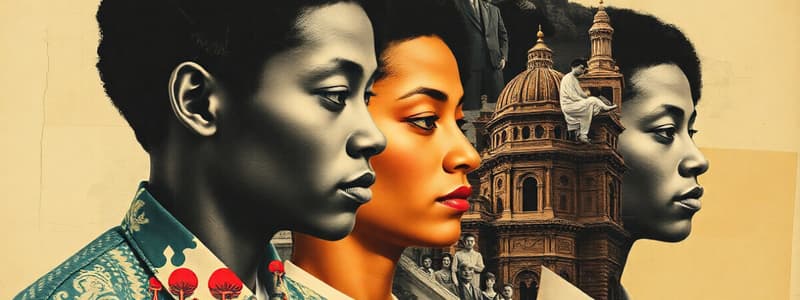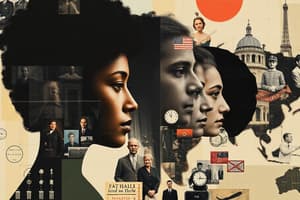Podcast
Questions and Answers
What best describes social structure?
What best describes social structure?
- A framework for economic institutions
- A unique behavior exhibited by individuals
- A pre-existing pattern of social behavior and organization (correct)
- A random assortment of social behaviors
Which statement aligns with the concept of social construction?
Which statement aligns with the concept of social construction?
- All perceptions of reality are universally accepted.
- Reality exists independent of human perception.
- Reality is solely determined by biological factors.
- Cultural and historical contexts shape our understanding of reality. (correct)
According to the Thomas theorem, if an individual believes something is real, what is the implication?
According to the Thomas theorem, if an individual believes something is real, what is the implication?
- The belief must be verified through science.
- The belief does not affect reality.
- The individual will be rejected by society.
- The belief becomes real in its consequences. (correct)
In racial formation theory, how is race defined?
In racial formation theory, how is race defined?
Which of the following statements about ethnicity is correct?
Which of the following statements about ethnicity is correct?
What happens during the externalization stage of reality construction?
What happens during the externalization stage of reality construction?
What characterizes the objectivation stage of social construction of reality?
What characterizes the objectivation stage of social construction of reality?
What role do moral entrepreneurs play in the externalization stage?
What role do moral entrepreneurs play in the externalization stage?
What does intersectionality primarily refer to?
What does intersectionality primarily refer to?
What is considered a master status?
What is considered a master status?
Which of the following best describes social roles?
Which of the following best describes social roles?
What are gender roles typically associated with?
What are gender roles typically associated with?
What is role strain?
What is role strain?
What is role conflict?
What is role conflict?
What does identity theory, proposed by Sheldon Stryker, emphasize?
What does identity theory, proposed by Sheldon Stryker, emphasize?
How is imposter syndrome primarily characterized?
How is imposter syndrome primarily characterized?
What does high commitment lead to in regard to identity salience?
What does high commitment lead to in regard to identity salience?
According to Stryker, how does the identity hierarchy change?
According to Stryker, how does the identity hierarchy change?
What is a primary concept of Goffman's theory on roles?
What is a primary concept of Goffman's theory on roles?
What is meant by 'interactional commitment'?
What is meant by 'interactional commitment'?
What happens during the internalization stage of the social construction of reality?
What happens during the internalization stage of the social construction of reality?
How does ascribed status differ from achieved status?
How does ascribed status differ from achieved status?
How did Goffman’s view on self-concept differ from Stryker's?
How did Goffman’s view on self-concept differ from Stryker's?
Which of the following best describes 'race' in the context of society?
Which of the following best describes 'race' in the context of society?
What does 'impression management' entail according to Goffman?
What does 'impression management' entail according to Goffman?
What is the relationship between high salience and role behavior?
What is the relationship between high salience and role behavior?
What is one effect of the internalization of ideas within a group?
What is one effect of the internalization of ideas within a group?
How does Stryker define commitment in relation to identity?
How does Stryker define commitment in relation to identity?
Which statement about status is true?
Which statement about status is true?
What does the term 'ethnicity' refer to?
What does the term 'ethnicity' refer to?
What does the term 'ableism' denote in terms of social status?
What does the term 'ableism' denote in terms of social status?
Why are urban legends significant in society?
Why are urban legends significant in society?
Flashcards are hidden until you start studying
Study Notes
Social Structure
- Pre-existing patterns of social behavior and the organization of society into predictable relationships.
Social Construction
- Reality is a product of cultural and historical timeframes, determined by societal agreement rather than inherent natural characteristics.
- Thomas Theorem (1923): If an individual believes something is real, it has real consequences.
Racial Formation Theory (Omi & Winant, 1989)
- Race is a social construct, determined by societal variables.
- Racial categories have evolved throughout history.
- Individuals may claim racial identities, but society might reject those claims based on its own standards.
- Race is not based on biological indicators, rather social constructs.
Ethnic Groups
- Are set apart by national origin or distinctive cultural patterns.
- Behavioral differences are learned through socialization and interaction, not biology.
Social Construction of Reality (Berger & Luckmann, 1966)
- Three-stage model explaining the construction of reality:
- Externalization: Individuals develop ideas about the world and try to persuade others. Moral entrepreneurs (Becker, 1963) promote their version of reality as the "correct" one.
- Objectivation: Externalized ideas are viewed as "fact," existing independent of their originators. Ideas are considered for truthfulness and spread through social interaction. Urban legends, often reflecting societal fears and values, are an example.
- Internalization: Ideas, now seen as true by many, become incorporated into individual beliefs and behaviors. People lose awareness that "reality" is simply a set of ideas, treating them as inherent truths.
Elements of Structure: Status
- Status represents a defined position within a group or society.
- Ascribed Status: A position assigned based on social criteria without regard for individual characteristics or abilities. Examples include race, ethnicity, class, gender, sexual orientation, and ability.
- Achieved Status: A position earned through effort and actions.
Intersectionality
- A concept describing how various forms of inequality (racism, sexism, homophobia, transphobia, ableism, classism) are interconnected and should not be examined in isolation.
Elements of Structure: Roles
- Social Roles: Sets of expectations for individuals occupying a specific status.
- Role Strain: Difficulty meeting the responsibilities of a particular role.
- Imposter Syndrome: Doubting one's abilities and believing they are a fraud, often experienced by high-achievers.
- Role Conflict: When expectations of two or more roles demand contradictory behaviors.
Identity Theory (Stryker, 1980)
- Identity: The collection of roles and their associated meanings within one's self-concept.
- Roles are hierarchically organized, with the most salient (important) identities at the top, greatly influencing thoughts, actions, feelings, and beliefs.
- Commitment: The cost of abandoning a particular identity.
- Interactional Commitment: Relationships that would be lost by leaving a role.
- Affective Commitment: Emotional costs associated with leaving a role.
- High commitment leads to increased role salience, leading people to spend more time in that role, seek opportunities to play it, and see neutral situations as suitable for the role.
- Identity hierarchy is relatively stable and changes only with significant life events.
Roles and Dramaturgy (Goffman)
- Dramaturgy: Viewing social behavior as a theatrical performance.
- Impression Management: Attempting to present the most favorable image of oneself to achieve a particular outcome.
- Roles are more fluid and situational, adopted to create a good impression for the current audience.
- Self-concept is constantly changing and adapted to the context.
- We constantly manage impressions in social interaction.
Summary: Goffman vs. Stryker
- Goffman: Self-concept is fluid and determined by the situation and audience.
- Stryker: Self-concept is stable and only changes with significant life events.
Studying That Suits You
Use AI to generate personalized quizzes and flashcards to suit your learning preferences.




